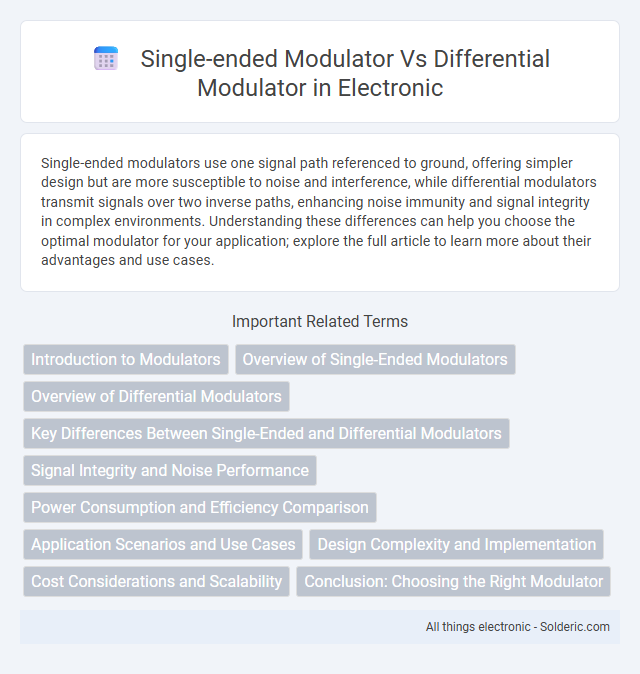Single-ended modulators use one signal path referenced to ground, offering simpler design but are more susceptible to noise and interference, while differential modulators transmit signals over two inverse paths, enhancing noise immunity and signal integrity in complex environments. Understanding these differences can help you choose the optimal modulator for your application; explore the full article to learn more about their advantages and use cases.
Comparison Table
| Feature | Single-Ended Modulator | Differential Modulator |
|---|---|---|
| Signal Type | Single-ended signal referenced to ground | Two complementary signals, differential pair |
| Noise Immunity | Lower noise rejection, susceptible to common-mode noise | High noise immunity due to common-mode noise rejection |
| Output Swing | Limited by supply voltage and ground reference | Typically larger effective output voltage swing |
| Complexity | Simpler circuit design and lower cost | More complex design, higher component count |
| Power Consumption | Generally lower power consumption | Higher power consumption due to differential pairs |
| Applications | Low frequency, less noise-sensitive applications | High-speed, precision, and noise-sensitive applications |
Introduction to Modulators
Single-ended modulators utilize a single signal path referenced to a common ground, often resulting in simpler design and lower power consumption, while differential modulators process two complementary signals to enhance noise immunity and reduce distortion. The choice between single-ended and differential modulators significantly impacts the modulation fidelity, linearity, and signal-to-noise ratio in communication systems. Differential modulators are preferred in high-performance applications requiring robust interference rejection, whereas single-ended modulators suit cost-sensitive or space-constrained designs.
Overview of Single-Ended Modulators
Single-ended modulators utilize a single input signal path to modulate a carrier, making them simpler and more cost-effective than differential modulators. They are commonly employed in low-frequency and low-power applications where noise immunity and signal integrity are less critical. Single-ended designs often face limitations in common-mode noise rejection and linearity compared to differential modulators, which use paired signals for improved performance.
Overview of Differential Modulators
Differential modulators utilize paired input signals to encode information by modulating the difference between them, enhancing noise immunity and signal integrity in communication systems. These modulators are widely applied in high-speed data transmission and analog-to-digital conversion due to their robustness against common-mode interference. Compared to single-ended modulators, differential designs provide improved linearity and reduced electromagnetic interference, making them essential in precision measurement and modern electronic circuitry.
Key Differences Between Single-Ended and Differential Modulators
Single-ended modulators process signals referenced to a common ground, resulting in simpler circuit design but higher susceptibility to noise and interference. Differential modulators handle signals as voltage differences between two lines, offering improved noise immunity and better signal integrity especially in high-speed and high-precision applications. The key differences lie in noise rejection capabilities, circuit complexity, and suitability for environments with varying electromagnetic interference levels.
Signal Integrity and Noise Performance
Single-ended modulators typically exhibit lower signal integrity due to susceptibility to common-mode noise, resulting in increased distortion and reduced signal quality. Differential modulators offer enhanced noise performance by leveraging their ability to reject common-mode interference, thereby significantly improving signal fidelity and minimizing harmonic distortion. The inherent symmetry in differential modulators ensures superior linearity and reduced electromagnetic interference, making them ideal for high-precision and low-noise applications.
Power Consumption and Efficiency Comparison
Single-ended modulators typically consume less power due to their simpler design, making them suitable for low-power applications. Differential modulators offer higher efficiency and improved noise immunity by utilizing balanced signals, which reduces distortion and power loss. Your choice depends on whether minimizing power consumption or maximizing signal integrity is more critical for the specific application.
Application Scenarios and Use Cases
Single-ended modulators are commonly used in low-power, cost-sensitive applications such as battery-powered sensors and simple audio devices due to their simpler design and lower component count. Differential modulators excel in high-performance communication systems, including RF transmitters and receivers, by providing better noise immunity and reduced interference through balanced signal processing. Industrial automation and medical instrumentation often prefer differential modulation to ensure signal integrity in electromagnetically noisy environments.
Design Complexity and Implementation
Single-ended modulators feature simpler design and easier implementation due to their straightforward signal path, making them suitable for applications with limited resources and space. Differential modulators involve more complex circuitry, including matched pairs of components, which enhances noise immunity and signal integrity but increases design effort and manufacturing costs. Choosing the right modulator depends on your project's requirements for performance versus complexity in the implementation phase.
Cost Considerations and Scalability
Single-ended modulators generally offer lower cost due to simpler circuitry and fewer components, making them suitable for budget-sensitive applications. Differential modulators, while more expensive, provide enhanced noise immunity and scalability for complex systems requiring high performance and long-term reliability. Your choice depends on balancing initial investment against future expansion and signal integrity needs.
Conclusion: Choosing the Right Modulator
Selecting the right modulator depends on application requirements such as noise immunity, signal integrity, and power consumption. Single-ended modulators offer simplicity and lower power usage, making them ideal for low-cost, space-constrained designs. Differential modulators provide superior noise rejection and signal quality, favored in high-performance and high-speed communication systems.
Single-ended modulator vs differential modulator Infographic

 solderic.com
solderic.com